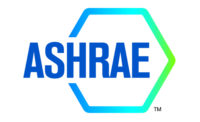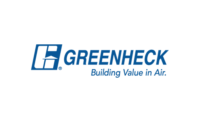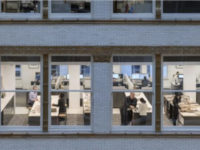Cathy Crowley, mechanical director, Mason & Hanger, shares a list of best practices her firm developed to provide the safest environment for employees returning to brick-and-mortar work locations on a recent episode of the Percussive Maintenance Podcast. Here’s a transcript of that interview.
Engineered Systems: Cathy, welcome to the podcast. Could you please introduce yourself to our listeners?
Cathy Crowley: My name is Cathy Crowley, and I'm a mechanical engineer and the director of Mason and Hanger, a full-service architectural engineering firm. We primarily service the U.S. government. A lot of our clients are Army, Army Reserves, and the Department of State along with other government agencies. We actually do work all over the world. Our mission statement is “Building a More Secure World.” Right now we have five offices located throughout the U.S. And, as director, I oversee the mechanical and plumbing staff in all of those offices.
Engineered Systems: So, how has the COVID-19 pandemic impacted the work you guys do at Mason and Hanger?
Crowley: Well, we went remote back on March 17. Everyone took their monitors and desktops and laptops home. I took my work chair home. Because we served the federal government, where the work and the mission doesn't really stop, so we're operating pretty close to how we were from our offices — our deadlines are continuing to be met and projects are continuing to come in. We've seen a few delays in our project schedules but not really that many. Our greatest impact has come from the inability to travel to sites for project meetings, though we're able to use what everyone else is using, Zoom and other technologies like that. Some of our projects require a site investigation early on in the project, before you can really get going, and that's where we've seen the most delays. But, as we start to open up a little bit, we're seeing a bit more day travel happening. We’re committed to follow all the protocols and procedures, and we hope to have the ability to travel overseas again as soon as August.
Engineered Systems: That seems like quite an ambitious goal.
Crowley: It may be a bit ambitious. Though, we recently used some 3-D laser scanning technology to support one of our clients, who was supposed to have a preview meeting with a large number of people visit the site. But they couldn't, obviously, due to travel restrictions and social distancing. So, we weren’t going to be able to award the project. But, we suggested using 3-D laser scanning technology, and we ended up sending two people to the site to scan the project. And they even put the scanning devices up in the attic. And then they used those to create a 3-D, photorealistic model that the vendors were able to walk through digitally to navigate the space. This allowed them to take accurate measurements and allowed the process to bid, just like normal, which is pretty cool.
Engineered Systems: So, it seems like every day we're getting a little closer to reopening America. And when that happens, corporations and businesses will be challenged to examine the elements necessary to provide the safest environment for employees returning to these brick-and-mortar work locations. As a mechanical engineer and designer of secured government facilities, Mason and Hangar recently created a list of recommendations engineers should consider when reviewing current and future building plans. Atop that list is increased air-change rates and the ability to flush out air. Can you dig a little bit more into that first bullet point?
Crowley: Before we get into the first bullet point, I would like to point out that this is just a list of potential modifications that are possible. It's not like a laundry list that somebody just goes and applies. Our recommendations for building owners who are looking at what engineer controls they can do is that they look to a professional for guidance and get a full evaluation of all these changes and how their buildings may be affected by these alterations. But getting into the first one, with the air change rate in the buildings and the ability to flush out air, obviously, the goal of a flush out is remove as much of the building air as possible and replace it with cleaner outside air. Everything we're hearing is that the outside air is cleaner, and you're less likely in less risk by breathing in outside air, so that's why increasing that amount of outside air is going to improve the building’s IAQ and reduce the risk of contaminants. But, obviously, an increase in the air change rate is going to impact the heating/cooling and dehumidification demand to the building. So, we need to look at the building and how it's going to handle that. Are the coils and the chiller sized adequately? You don't want to be adding ventilation load into a building that's already struggling to meet its demand.
Engineered Systems: Right, and the controls system has to be altered accordingly. Any controls strategies that bear mentioning?
Crowley: I think it'd be important to take a look at what control strategies are in place. One big factor would be if there's a demand control ventilation strategy, which provides an energy savings. If you can reduce the outside air and still have a good air quality, then you're going to save energy by not treating that outside air. But, right now, if we're looking at increasing the outside air to improve the air inside the building, we want to turn that strategy off, at least in the near future.
Engineered Systems: Next on your list is filtration. Can you talk a little bit more about that?
Crowley: Yeah. Right now, both the World Health Organization and CDC are kind of downplaying the likelihood of airborne transmission, though they both acknowledges the possibility, so the consensus really from these organizations is that the majority of the cases are from large air droplets at a close range. But, I did see one study that showed that airborne transmission in a laboratory setting. As things are opening, the CDC is talking about outside seating in a restaurant is safe, but the inside is not. Ultimately, I believe they’re telling us that better filters probably will have some benefit, so it makes sense to evaluate them. This is also a fairly simple modification, but what we need to do is take a look at the return air path and not the outside air. It's not as effective to revise the filtration on the outside air coming into the building but you want to look at the return air path. Is it possible to replace a 1-inch filter that's a MERV-7 with a 1-inch MERV-13 filter? Or do you have a MERV-12 or MERV-13 that you can replace with a MERV-14 filter? But, again, this is an item for the engineers to look at because when increasing the the MERV rating on a filter, it increases the static pressure and reduces the airflow. So, if you have a building that is already struggling to meet demand, you don't want to add that load to the building. But, you know, when engineers evaluate it, they're going to look at the trending data, and how that building's been operating. So, if the filter capacity has been running at about 50% capacity, and maybe you're bringing in your people at about 50%, you can probably handle that increase because maybe you don't need as much airflow to cool a facility if you're if you're only brining in 50% of the capacity. Another thing people ask about are HEPA filters, which are 99.9% efficient. Those clearly would be the most effective way to capture airborne particle transmissions, but it may not really be practical or warranted because of the substantial costs associated with them versus the relatively low risk of airborne transmission in the office environment.
Engineered Systems: In your opinion, should engineers consider UV-C as part of the equation?
Crowley: I think the UV-C is going to have a little less impact, just because it's going to be a little bit more difficult to determine how to implement it than some of the other measures. In order for the UV light to kill the pathogens, there needs to be a certain amount of exposure time to that UV-C light, which is going to make it more difficult to achieve, whether you need 7 feet of ductwork or a little bit more for that because the airstream is moving at a certain velocity. UV-C does a great job of removing gunk off of cooling coils, the coils aren't moving in the airstream.
Engineered Systems: What's next on the list Cathy?
Crowley: Next on the list is the separation within buildings pressurization. I believe that one has a smaller role, as people are looking at moving back into buildings, but it could be something that we look at when we're designing new buildings. It's just something that's a little bit more difficult to retrofit. But, if we're going on the assumption that there's a possibility of the airborne transmission, having pressurized areas kind of contains the virus within small zones, right?
Engineered Systems: And, of course, social distancing, will continue to play a role as we continue to move through this pandemic, correct?
Crowley: Yeah, it looks like the social distancing, the masks, the hand washing, and the surface cleaning are all having the greatest impact right now. I know our company has implemented each of those. The ASHRAE Epidemic Task Force is looking at how we can come back and maintain all those recommended practices. You know, do we add height to the cubicle walls, make traffic in hallways one way, limit the number of the people in the bathrooms or break rooms, etc? All these are important to help to reduce our risk. The virus is probably going to be around a while.
Engineered Systems: Retro-commissioning is another key component that engineers should incorporate into their operations. How frequently should we be considering retro-commissioning? And what specifically should engineers be looking for?
Crowley: The recommendation is three to five years and that really depends on how well a building is being maintained and monitored. Some buildings actually have never been commissioned. So, definitely, we would recommend retro-commissioning for those buildings. A building owner or even the occupants of the building are going to know when an air handling unit fails completely, but what we don't know is when there are the small failures that really don't set off an alarm or anything like that. These are affecting the operation and the efficiency of the ducting. A lot of times, commissioning, in the beginning was like, how can we improve efficiency by making sure everything's running. But, we also want to make sure things like damper actuators are not failed open or closed. Maybe the air-handling units are running, but maybe you're getting half the amount of outside air that you wanted to get. So, we want to make sure the control strategy is operating as its intended, because it's harder to understand what's being affected. If your building's not operating as you want it to, sometimes, temperature sets get adjusted and then they never get put back. Things like that that are small, though it's always good to fix that them and the commissioning agent kinds of checks everything, understands how it's all operating, and then provides a list of recommendations for repairs to the owner.
Engineered Systems: Moving forward, what's considered normal is certainly not going to be the same as the “old” normal. Will different will this “new” normal be from how we conducted our previous lives?
Crowley: I think COVID-19 is definitely going to change how we live and work, at least for the next several years, until we develop a vaccine, but even possibly after that. That's not my area of expertise, but, as we go back to the office, how we work is going to change. I used to be a big proponent of having the ability to get up from my desk to walk over to the electrical engineers to have a face-to-face conversation versus picking up the phone or emailing. Technology is going to be a large part of our work as we continue to utilize the cameras on your computers to see your coworkers when you're talking to them. And, you know, even though we have these big conference rooms, they might not be used when we go back. We might still be using Zoom, even though we're all sitting at our desks. Break rooms and common coffee may be a thing of the past. And how we, how we move about in a building, it's all that the work is going to change. But everyone's changed in their personal lives and is dealing with this in different ways, depending on where they are in life. My daughter's a senior in high school, so we don't even know if she's going to be moving into the dorms this fall. There's a lot of changes. Before we went remote, I wouldn't have guessed that we would be here today. So, you know, it's going to be interesting to see where we are going forward.
Engineered Systems: I agree, there are a lot of unknowns, and we're all sort of looking for a playbook. Perhaps the best resources we have are those provided by ASHRAE and the CDC, as we attempt to navigate this new existence. Would you agree with that?
Crowley: Oh yeah, for sure. I'd always expect and trust ASHRAE to take a strong lead. I know in May they released the COVID-19 Building Readiness Reopening guidance. And that's already something to help people as they move back with similar things to what we're talking about today. So, I'm assuming that they're already taking a look at how this changes things in the future. All of us in the industry look to ASHRAE as a leader.
Engineered Systems: So, Cathy, we've covered quite a bit, but is there anything else engineers should consider as they prepare to open up their facilities that have sat dormant?
Crowley: Yeah, I think most buildings have been operating at some capacity to maintain temperature and humidity, but they're probably operating at an occupied mode so that they don't have minimal outside air coming in or possibly no outside air and then just recirculating the building air. So, even though you know there haven't been people in there, it probably is good just to have that building run in an occupied mode for a day or two, just to kind of refresh that air, like we talked about changing the air change rate and then flushing it out. If there's an economizer cycle, which is bringing in 100% outside air and exhausting the air, that's a good thing to do for maybe a couple hours. Also, plan ahead, as you don't want to do it on a rainy humid day or anything like that.
Engineered Systems: If you could leave consulting and specifying engineers with one thought from this interview, what would it be?
Crowley: I would think it's a good time to be thinking about how we change our project designs in the future. And this would not be just for you know, an HVAC designer but for architects and interior design and even the plumbing designs. For a long time we've been having these open, large common areas with cubicles and my guess is we're going to be reducing that to maybe smaller ones, or perhaps we add more offices, or our cubicle walls are going to be higher and even how we designed bathrooms. We're going to be going through our building without touching things.
Engineered Systems: OK, this has been fantastic. If listeners are interested in connecting with you or Mason and Hanger, where should they turn?
Crowley: They can find me on LinkedIn at Catherine Crowley. If anyone's interested in reading up on projects and services that Mason and Hanger provides, they can go to our website at www.masonandhanger.com. We're pretty proud of our mission and our work, and we have some pretty interesting and unique projects that are featured in each of the markets on the site.
Engineered Systems: Thank you so much for your time today. We appreciate you sharing your thoughts and we hope to chat again with you soon. Please stay safe. Thank you!





